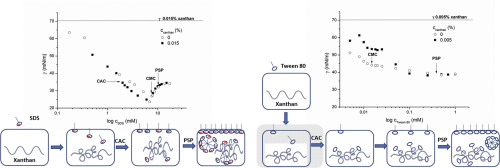当前位置:
X-MOL 学术
›
Food Hydrocoll.
›
论文详情
Our official English website, www.x-mol.net, welcomes your
feedback! (Note: you will need to create a separate account there.)
Application of different techniques in the determination of xanthan gum-SDS and xanthan gum-Tween 80 interaction
Food Hydrocolloids ( IF 11.0 ) Pub Date : 2019-02-01 , DOI: 10.1016/j.foodhyd.2018.07.040 Veljko Krstonošić , Maja Milanović , Ljubica Dokić
Food Hydrocolloids ( IF 11.0 ) Pub Date : 2019-02-01 , DOI: 10.1016/j.foodhyd.2018.07.040 Veljko Krstonošić , Maja Milanović , Ljubica Dokić

|
Abstract Polymer - surfactant aqueous systems are important for a variety of industrial applications. The properties of those systems among other depend on the interactions between them. The aim of this work was to determine interactions between anionic polymer - xanthan gum and anionic surfactant - SDS or nonionic surfactant - Tween 80. In order to get better insight into the occurrence and possible mechanism of interactions several techniques were used such as FTIR, viscometry, conductometry, tensiometry, fluorimetry as well as SEM analysis. The results obtained by the combination of all those techniques showed that xanthan gum – SDS/Tween 80 interactions existed. Structural changes of xanthan gum molecules in presence of both surfactants were obtained by viscometry and SEM. The characteristic interaction points (CAC and PSP) were determined by measuring surface tension and specific conductance of pure surfactant aqueous solutions and their mixtures with xanthan gum. The values of PSP were proportional to the polymer concentration. After overcoming electrostatic repulsion between xanthan gum and SDS, they form complexes through hydrophobic mechanism and enhance adsorption of SDS molecules at the water – air interface. Unlike SDS, Tween 80 mainly interacts with xanthan gum in the bulk creating hydrogen bonds as well as by hydrophobic interactions. The results of fluorescence measurements expressed as I1/I3 ratio additionally confirmed that the mechanism of interactions between xanthan gum and examined surfactants was mainly through hydrophobic interaction and by creation the hydrogen bonds with Tween 80 as through electrostatic repulsion with SDS.
中文翻译:

不同技术在测定黄原胶-SDS和黄原胶-吐温80相互作用中的应用
摘要 聚合物-表面活性剂水性体系对于各种工业应用很重要。这些系统的特性取决于它们之间的相互作用。这项工作的目的是确定阴离子聚合物 - 黄原胶和阴离子表面活性剂 - SDS 或非离子表面活性剂 - 吐温 80 之间的相互作用。 为了更好地了解相互作用的发生和可能的机制,使用了几种技术,例如 FTIR、粘度计、电导测定法、张力测定法、荧光测定法以及 SEM 分析。通过所有这些技术的组合获得的结果表明存在黄原胶 - SDS/吐温 80 相互作用。通过粘度测定法和扫描电镜获得了在两种表面活性剂存在下黄原胶分子的结构变化。通过测量纯表面活性剂水溶液及其与黄原胶的混合物的表面张力和电导率来确定特征相互作用点(CAC 和 PSP)。PSP 的值与聚合物浓度成正比。黄原胶与SDS之间克服静电排斥后,通过疏水机制形成复合物,增强SDS分子在水-气界面的吸附。与 SDS 不同,吐温 80 主要与本体中的黄原胶相互作用,产生氢键以及疏水相互作用。
更新日期:2019-02-01
中文翻译:

不同技术在测定黄原胶-SDS和黄原胶-吐温80相互作用中的应用
摘要 聚合物-表面活性剂水性体系对于各种工业应用很重要。这些系统的特性取决于它们之间的相互作用。这项工作的目的是确定阴离子聚合物 - 黄原胶和阴离子表面活性剂 - SDS 或非离子表面活性剂 - 吐温 80 之间的相互作用。 为了更好地了解相互作用的发生和可能的机制,使用了几种技术,例如 FTIR、粘度计、电导测定法、张力测定法、荧光测定法以及 SEM 分析。通过所有这些技术的组合获得的结果表明存在黄原胶 - SDS/吐温 80 相互作用。通过粘度测定法和扫描电镜获得了在两种表面活性剂存在下黄原胶分子的结构变化。通过测量纯表面活性剂水溶液及其与黄原胶的混合物的表面张力和电导率来确定特征相互作用点(CAC 和 PSP)。PSP 的值与聚合物浓度成正比。黄原胶与SDS之间克服静电排斥后,通过疏水机制形成复合物,增强SDS分子在水-气界面的吸附。与 SDS 不同,吐温 80 主要与本体中的黄原胶相互作用,产生氢键以及疏水相互作用。











































 京公网安备 11010802027423号
京公网安备 11010802027423号